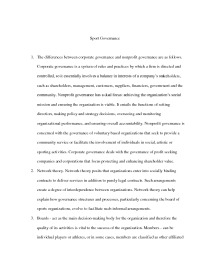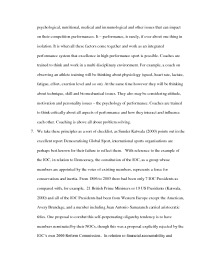Sport Governance



Sport Governance.
The differences between corporate governance and nonprofit governance are as follows. Corporate governance is a system of rules and practices by which a firm is directed and controlled, so it essentially involves a balance in interests of a company’s stakeholders, such as shareholders, management, customers, suppliers, financiers, government and the community. Nonprofit governance has a dual focus: achieving the organization’s social mission and ensuring the organization is viable. It entails the functions of setting direction, making policy and strategy decisions, overseeing and monitoring organizational performance, and ensuring overall accountability. Nonprofit governance is concerned with the governance of voluntary based organizations that seek to provide a community service or facilitate the involvement of individuals in social, artistic or sporting activities. Corporate governance deals with the governance of profit seeking companies and corporations that focus protecting and enhancing shareholder value.
Network theory. Network theory posits that organizations enter into socially binding contracts to deliver services in addition to purely legal contracts. Such arrangements create a degree of interdependence between organizations. Network theory can help explain how governance structures and processes, particularly concerning the board of sports organizations, evolve to facilitate such informal arrangements.
Boards - act as the main decision-making body for the organization and therefore the quality of its activities is vital to the success of the organization. Members - can be individual players or athletes, or in some cases, members are classified as other affiliated organizations such as a club that competes in a league provided by a regional sports association. The membership council comprises those people or organizations that are registered members and who may be allocated voting rights according to membership status. Staff and Volunteers - must work with a variety of volunteers in sport to deliver essential services such as coaching, player and official development, marketing, sport development and event delivery. Stakeholders - such as sponsors, funding agencies, members, affiliated organizations, staff, board members, venues, government agencies and suppliers must be consulted and managed in order for the organization to operate optimally.
- Business & Entrepreneurship Essays
- Microsoft Word 11 KB
- 2020 m.
- English
- 7 pages (1821 words)
- University
- Matas

















